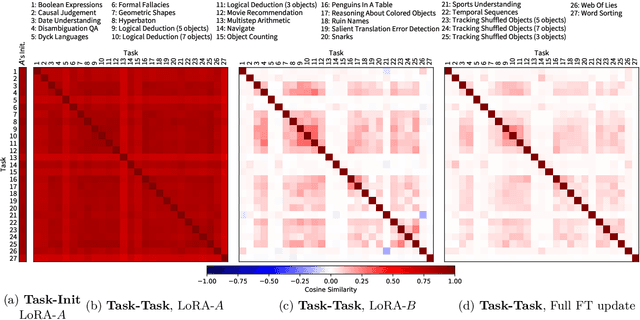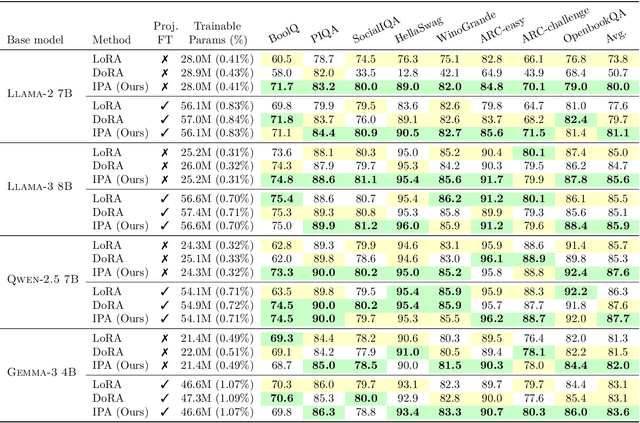Matthieu Cord
SSDD: Single-Step Diffusion Decoder for Efficient Image Tokenization
Oct 06, 2025Abstract:Tokenizers are a key component of state-of-the-art generative image models, extracting the most important features from the signal while reducing data dimension and redundancy. Most current tokenizers are based on KL-regularized variational autoencoders (KL-VAE), trained with reconstruction, perceptual and adversarial losses. Diffusion decoders have been proposed as a more principled alternative to model the distribution over images conditioned on the latent. However, matching the performance of KL-VAE still requires adversarial losses, as well as a higher decoding time due to iterative sampling. To address these limitations, we introduce a new pixel diffusion decoder architecture for improved scaling and training stability, benefiting from transformer components and GAN-free training. We use distillation to replicate the performance of the diffusion decoder in an efficient single-step decoder. This makes SSDD the first diffusion decoder optimized for single-step reconstruction trained without adversarial losses, reaching higher reconstruction quality and faster sampling than KL-VAE. In particular, SSDD improves reconstruction FID from $0.87$ to $0.50$ with $1.4\times$ higher throughput and preserve generation quality of DiTs with $3.8\times$ faster sampling. As such, SSDD can be used as a drop-in replacement for KL-VAE, and for building higher-quality and faster generative models.
RAP: 3D Rasterization Augmented End-to-End Planning
Oct 05, 2025Abstract:Imitation learning for end-to-end driving trains policies only on expert demonstrations. Once deployed in a closed loop, such policies lack recovery data: small mistakes cannot be corrected and quickly compound into failures. A promising direction is to generate alternative viewpoints and trajectories beyond the logged path. Prior work explores photorealistic digital twins via neural rendering or game engines, but these methods are prohibitively slow and costly, and thus mainly used for evaluation. In this work, we argue that photorealism is unnecessary for training end-to-end planners. What matters is semantic fidelity and scalability: driving depends on geometry and dynamics, not textures or lighting. Motivated by this, we propose 3D Rasterization, which replaces costly rendering with lightweight rasterization of annotated primitives, enabling augmentations such as counterfactual recovery maneuvers and cross-agent view synthesis. To transfer these synthetic views effectively to real-world deployment, we introduce a Raster-to-Real feature-space alignment that bridges the sim-to-real gap. Together, these components form Rasterization Augmented Planning (RAP), a scalable data augmentation pipeline for planning. RAP achieves state-of-the-art closed-loop robustness and long-tail generalization, ranking first on four major benchmarks: NAVSIM v1/v2, Waymo Open Dataset Vision-based E2E Driving, and Bench2Drive. Our results show that lightweight rasterization with feature alignment suffices to scale E2E training, offering a practical alternative to photorealistic rendering. Project page: https://alan-lanfeng.github.io/RAP/.
IPA: An Information-Preserving Input Projection Framework for Efficient Foundation Model Adaptation
Sep 04, 2025



Abstract:Parameter-efficient fine-tuning (PEFT) methods, such as LoRA, reduce adaptation cost by injecting low-rank updates into pretrained weights. However, LoRA's down-projection is randomly initialized and data-agnostic, discarding potentially useful information. Prior analyses show that this projection changes little during training, while the up-projection carries most of the adaptation, making the random input compression a performance bottleneck. We propose IPA, a feature-aware projection framework that explicitly preserves information in the reduced hidden space. In the linear case, we instantiate IPA with algorithms approximating top principal components, enabling efficient projector pretraining with negligible inference overhead. Across language and vision benchmarks, IPA consistently improves over LoRA and DoRA, achieving on average 1.5 points higher accuracy on commonsense reasoning and 2.3 points on VTAB-1k, while matching full LoRA performance with roughly half the trainable parameters when the projection is frozen.
Scaling Laws for Native Multimodal Models Scaling Laws for Native Multimodal Models
Apr 10, 2025



Abstract:Building general-purpose models that can effectively perceive the world through multimodal signals has been a long-standing goal. Current approaches involve integrating separately pre-trained components, such as connecting vision encoders to LLMs and continuing multimodal training. While such approaches exhibit remarkable sample efficiency, it remains an open question whether such late-fusion architectures are inherently superior. In this work, we revisit the architectural design of native multimodal models (NMMs)--those trained from the ground up on all modalities--and conduct an extensive scaling laws study, spanning 457 trained models with different architectures and training mixtures. Our investigation reveals no inherent advantage to late-fusion architectures over early-fusion ones, which do not rely on image encoders. On the contrary, early-fusion exhibits stronger performance at lower parameter counts, is more efficient to train, and is easier to deploy. Motivated by the strong performance of the early-fusion architectures, we show that incorporating Mixture of Experts (MoEs) allows for models that learn modality-specific weights, significantly enhancing performance.
VaViM and VaVAM: Autonomous Driving through Video Generative Modeling
Feb 21, 2025Abstract:We explore the potential of large-scale generative video models for autonomous driving, introducing an open-source auto-regressive video model (VaViM) and its companion video-action model (VaVAM) to investigate how video pre-training transfers to real-world driving. VaViM is a simple auto-regressive video model that predicts frames using spatio-temporal token sequences. We show that it captures the semantics and dynamics of driving scenes. VaVAM, the video-action model, leverages the learned representations of VaViM to generate driving trajectories through imitation learning. Together, the models form a complete perception-to-action pipeline. We evaluate our models in open- and closed-loop driving scenarios, revealing that video-based pre-training holds promise for autonomous driving. Key insights include the semantic richness of the learned representations, the benefits of scaling for video synthesis, and the complex relationship between model size, data, and safety metrics in closed-loop evaluations. We release code and model weights at https://github.com/valeoai/VideoActionModel
GaussRender: Learning 3D Occupancy with Gaussian Rendering
Feb 07, 2025



Abstract:Understanding the 3D geometry and semantics of driving scenes is critical for developing of safe autonomous vehicles. While 3D occupancy models are typically trained using voxel-based supervision with standard losses (e.g., cross-entropy, Lovasz, dice), these approaches treat voxel predictions independently, neglecting their spatial relationships. In this paper, we propose GaussRender, a plug-and-play 3D-to-2D reprojection loss that enhances voxel-based supervision. Our method projects 3D voxel representations into arbitrary 2D perspectives and leverages Gaussian splatting as an efficient, differentiable rendering proxy of voxels, introducing spatial dependencies across projected elements. This approach improves semantic and geometric consistency, handles occlusions more efficiently, and requires no architectural modifications. Extensive experiments on multiple benchmarks (SurroundOcc-nuScenes, Occ3D-nuScenes, SSCBench-KITTI360) demonstrate consistent performance gains across various 3D occupancy models (TPVFormer, SurroundOcc, Symphonies), highlighting the robustness and versatility of our framework. The code is available at https://github.com/valeoai/GaussRender.
Towards Generalizable Trajectory Prediction Using Dual-Level Representation Learning And Adaptive Prompting
Jan 08, 2025



Abstract:Existing vehicle trajectory prediction models struggle with generalizability, prediction uncertainties, and handling complex interactions. It is often due to limitations like complex architectures customized for a specific dataset and inefficient multimodal handling. We propose Perceiver with Register queries (PerReg+), a novel trajectory prediction framework that introduces: (1) Dual-Level Representation Learning via Self-Distillation (SD) and Masked Reconstruction (MR), capturing global context and fine-grained details. Additionally, our approach of reconstructing segmentlevel trajectories and lane segments from masked inputs with query drop, enables effective use of contextual information and improves generalization; (2) Enhanced Multimodality using register-based queries and pretraining, eliminating the need for clustering and suppression; and (3) Adaptive Prompt Tuning during fine-tuning, freezing the main architecture and optimizing a small number of prompts for efficient adaptation. PerReg+ sets a new state-of-the-art performance on nuScenes [1], Argoverse 2 [2], and Waymo Open Motion Dataset (WOMD) [3]. Remarkable, our pretrained model reduces the error by 6.8% on smaller datasets, and multi-dataset training enhances generalization. In cross-domain tests, PerReg+ reduces B-FDE by 11.8% compared to its non-pretrained variant.
Analyzing Fine-tuning Representation Shift for Multimodal LLMs Steering alignment
Jan 06, 2025Abstract:Multimodal LLMs have reached remarkable levels of proficiency in understanding multimodal inputs, driving extensive research to develop increasingly powerful models. However, much less attention has been paid to understanding and explaining the underlying mechanisms of these models. Most existing explainability research examines these models only in their final states, overlooking the dynamic representational shifts that occur during training. In this work, we systematically analyze the evolution of hidden state representations to reveal how fine-tuning alters the internal structure of a model to specialize in new multimodal tasks. Using a concept-based approach, we map hidden states to interpretable visual and textual concepts, enabling us to trace changes in encoded concepts across modalities as training progresses. We also demonstrate the use of shift vectors to capture these concepts changes. These shift vectors allow us to recover fine-tuned concepts by shifting those in the original model. Finally, we explore the practical impact of our findings on model steering, showing that we can adjust multimodal LLMs behaviors without any training, such as modifying answer types, captions style, or biasing the model toward specific responses. Our work sheds light on how multimodal representations evolve through fine-tuning and offers a new perspective for interpreting model adaptation in multimodal tasks. The code for this project is publicly available at https://github.com/mshukor/xl-vlms.
PPT: Pre-Training with Pseudo-Labeled Trajectories for Motion Forecasting
Dec 09, 2024Abstract:Motion forecasting (MF) for autonomous driving aims at anticipating trajectories of surrounding agents in complex urban scenarios. In this work, we investigate a mixed strategy in MF training that first pre-train motion forecasters on pseudo-labeled data, then fine-tune them on annotated data. To obtain pseudo-labeled trajectories, we propose a simple pipeline that leverages off-the-shelf single-frame 3D object detectors and non-learning trackers. The whole pre-training strategy including pseudo-labeling is coined as PPT. Our extensive experiments demonstrate that: (1) combining PPT with supervised fine-tuning on annotated data achieves superior performance on diverse testbeds, especially under annotation-efficient regimes, (2) scaling up to multiple datasets improves the previous state-of-the-art and (3) PPT helps enhance cross-dataset generalization. Our findings showcase PPT as a promising pre-training solution for robust motion forecasting in diverse autonomous driving contexts.
GIFT: A Framework for Global Interpretable Faithful Textual Explanations of Vision Classifiers
Nov 23, 2024



Abstract:Understanding deep models is crucial for deploying them in safety-critical applications. We introduce GIFT, a framework for deriving post-hoc, global, interpretable, and faithful textual explanations for vision classifiers. GIFT starts from local faithful visual counterfactual explanations and employs (vision) language models to translate those into global textual explanations. Crucially, GIFT provides a verification stage measuring the causal effect of the proposed explanations on the classifier decision. Through experiments across diverse datasets, including CLEVR, CelebA, and BDD, we demonstrate that GIFT effectively reveals meaningful insights, uncovering tasks, concepts, and biases used by deep vision classifiers. Our code, data, and models are released at https://github.com/valeoai/GIFT.
 Add to Chrome
Add to Chrome Add to Firefox
Add to Firefox Add to Edge
Add to Edge